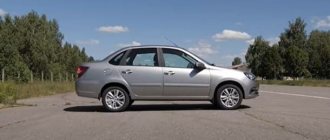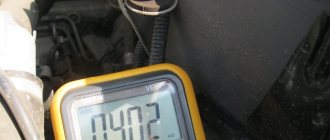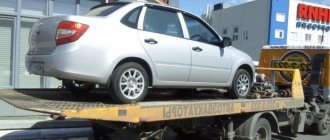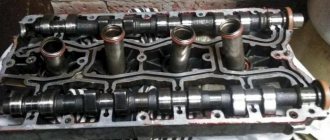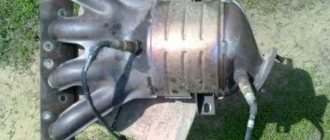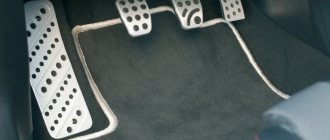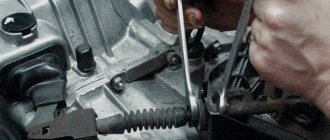When choosing a car, buyers pay special attention to ergonomics and ease of driving. Controls include not only the steering wheel, but also the gearbox and the pedals used in the car. When placing pedals in a car, all automakers adhere to generally accepted standards.
It is also interesting that on identical machines their number may differ. This directly depends on which gearbox is provided in a particular configuration. On manuals there are more control levers, on cars with automatic transmission there are fewer of them, since the need for one of the pedals disappears.
The first cars were equipped exclusively with mechanical transmissions, which made it possible to control the behavior of the car and its speed. Drivers accustomed to manual transmissions note that the mechanics allow you to fully feel the car, thereby feeling like you are in charge.
Then came automatic transmissions. Working with them has become much easier. Yes, many may argue that mechanics are the basis, and only such a box makes it possible to get the most out of the car. Currently, it is not necessary to know how to operate a manual transmission if you buy a car with an automatic transmission.
Location
The pedals are arranged in the same order. Regardless of whether the transmission is manual or automatic. Automatic machines, robots and CVTs have two pedals instead of three. Because there is no need to disengage the clutch.
An interesting fact: in right-hand drive cars that are driven in Japan and the UK, and sometimes found here, the position of the pedals coincides with the left-hand drive cars we are used to. And not in a mirror image, as some might imagine.
Hand brake
Some cars have a handbrake, parking brake, or brake control button (see above). Many other machines have a lever with a release button.
So, the car is moving. Now you need to make sure the handbrake is off. Since you are driving on a flat road, your car will not roll away while you are thinking about what to do next.
Car with manual transmission
Cars equipped with manual transmission have three pedals. The arrangement of the mechanic's pedals is as follows.
- Clutch . The clutch is controlled by the pedal on the far left. Disengaging the clutch makes switching between gears easier and reduces the load on the gearbox parts.
- Brake. The pedal in the middle causes the car to slow down and is called a brake. Pressing it engages the car's braking system, preventing the wheels from rotating. At the same time, the speed decreases until it stops.
- Gas. The farthest pedal on the right side is gas. Pressing it causes increased engine operation and acceleration of the car. The acceleration speed directly depends on the pressing force. It is recommended to apply pressure gradually and smoothly.
How to drive a car with an automatic transmission: gearbox
The automatic transmission has several modes.
When the lever is in position P, the drive wheels and shaft are locked. This mode is used when parking and long stops. You should switch to parking only after a complete stop. To move the lever to this position, you need to hold the brake. If you turn on P while driving a car with an automatic transmission, the car may break down.
If you park the car on a relatively flat surface, then using the handbrake may not be necessary. If the slope is steep, then you can additionally use the handbrake to relieve the load on the car’s mechanisms.
Automatic machine
There are only two pedals in an automatic car, because disengaging the clutch is not required. Gears change automatically.
- Brake. The pedal on the far left will be the brake. It is larger than in a manual car.
- Gas. The pedal on the right is gas.
The location of the automatic pedals is the same as that of the manual.
Functional Features
Having studied the features of the location of the pedals in cars with a manual transmission, it will not be difficult to finally remember where each is. Each of you understands that the pedals in the car play a certain role. Everyone has their own strictly assigned function. And they need to be taken into account when getting behind the wheel.
Let us remind you how the pedals in any car go from left to right on the driver’s side:
In an automatic transmission, everything goes exactly the same way, but only with the condition that there is no clutch in this sequence.
To better understand the functional features, you need to consider all the pedals separately.
Clutch
It's easy to remember where the clutch lever is located in your car. It is important to take into account that on all cars they are always in the same place. Car companies cannot place the clutch on the right or in the middle.
Now let’s talk more specifically about why such a control lever in a car as a clutch pedal is needed. Responsible for the connection between the gearbox and the engine, as well as disconnection as necessary. If the pedal is not touched, the engine will be connected to the gearbox, that is, at this time the clutch is considered to be engaged.
When the control lever is pressed to the floor, disengagement occurs and therefore the clutch is disengaged. In order for the car to start moving, the driver must turn the clutch back on. And to do this, simply release the pedal.
If you take into account the design, everything happens as follows:
- the clutch disc consisting of a pair of discs is located on the splines of the input shaft of the box, a rigid connection is used;
- in this case, the disk is clamped between the motor flywheel and the basket rings;
- when the pedal is pressed, a special spring releases the ring located on the basket;
- the ring moves away from the flywheel;
- the disk is released and it begins to rotate independently of this flywheel;
- now the driver changes gear and then releases the pedal;
- at the same time, the spring is released by the release bearing, the rings come back together, and the disk is clamped again.
This happens quickly and cyclically with every gear shift on a manual transmission.
When operating a car with a manual transmission, that is, if there is a clutch in the form of a pedal, you must adhere to some rules:
- You should always keep your left foot near the pedal so that you can press it at any time. Most cars are equipped with platforms to the left of the pedal, which is intended for the left foot and its rest between shifts. The main thing is to take a comfortable position so that your leg does not get tired.
- You don't have to keep your foot on the pedal all the time. Otherwise, the driver gets tired and the clutch itself wears out faster. Any even slight pressure creates a load, and therefore wear occurs.
- Always depress the control lever fully when changing from one speed to another.
- The left foot is used only to operate one pedal. And it's purely clutch.
- Pressing should be done completely, quickly, but without jerking. Try to do everything in one movement. This is where how comfortably you hold your foot comes into play.
- When you smoothly release the pedal, traction begins and the car moves. At this moment, you should stay in this position and drive literally 3 meters. This holding of the leg in the middle position is the optimal starting point. If you miss this moment, sharply remove the pedal or press the gas too quickly, you will end up slipping, the car will start to twitch and will probably stall. It is recommended to practice the start as much as possible. You need to get used to each specific car.
- Be sure to disengage the clutch before starting the engine. To do this, the pedal is pressed to the floor. Only then does the starter turn on.
- The clutch is used in three situations. This is the start of movement, switching gears and stopping completely.
It is the clutch that makes driving cars with manual transmission more difficult when compared with automatic transmission. But you get used to everything and you can learn everything.
Having the skills to control a manual transmission with a clutch pedal, switching to an automatic transmission will not be difficult. But if you learned to drive an automatic transmission, and then had to switch to a manual transmission, you can feel as if you were behind the wheel for the first time.
Brake
You already know where the brake pedal should be located in the car. If in a car with a manual transmission, then in the middle, and if with an automatic transmission, then on the left.
By pressing this control lever, the driver thereby transfers the load to the amplifier. It creates additional force on the master brake cylinder installed in the car. By releasing the pedal, the return spring allows you to return the element to its original position.
There is nothing complicated in the design of this component. This is a lever with a special platform for the foot on the bottom side. There are also a couple of holes near the top end. Through one hole passes a pin that allows the pedal to move back and forth in a confined space.
The second hole is needed to connect the vacuum booster to the plug. If there is no booster, then there is a connection to the master cylinder of the brake system. To create a reliable and movable connection, metal pins are used.
When the driver presses this pedal, any car is designed to automatically turn on the brake lights located behind the car.
It is also an accelerator or accelerator pedal. Here you should also understand what the accelerator pedal in a car is and how it works.
The element is designed to give the car acceleration. This is achieved by opening the throttle valve and increasing the amount of fuel entering the combustion chamber. The harder the driver presses the control lever, the more air-fuel mixture enters the combustion chamber. It is only important to take into account the fact that traditional and electronic pedals can be installed on cars.
If this is a mechanical standard pedal, then the design includes a cable drive for the damper. When the driver squeezes the element, the cable opens the throttle valve. The opening occurs exactly at the angle at which the cable rod was pressed.
With an electronic pedal, things are a little different. When you press the control lever to accelerate, a special sensor reads information about the angle of pressure and transmits it to the motor control unit. The block itself determines at what angle the throttle valve should be opened, after which it transmits the corresponding command to the actuator, that is, the drive.
Mechanical pedal operation
In a car with a manual transmission, turn off the handbrake. Then start the engine. To do this, turn the ignition key in the lock until it stops. After this, press the clutch and switch to first gear.
After which the clutch is released and the car begins to move. Next, the gas is smoothly squeezed out, and as it accelerates, gears are changed after pressing the clutch.
Gears must be changed both when accelerating and when decelerating. The stages are switched in order so as not to break the box and not throw the engine out of rhythm.
Gas, brake, clutch - must work as one team, otherwise there will be jerks, jerking of the car, and the engine will stall. When switching gears incorrectly or inconsistently, the gearbox crunches.
Adjust your mirrors
Adjust your side and rear view mirrors so that you can see what is happening behind you and to the sides. Make sure you are in an area where no one is around and there is enough road ahead of you that you can drive the car at different speeds without crashing into anyone.
Operation of automatic pedals
Automation control is much easier. There is no need to constantly disengage the clutch; the gears switch themselves in the required sequence using special clutches.
The lever only turns on the “D” mode for moving forward. Or “R”, for reversing the car. There may also be modes “P” - for long-term parking and “N” - corresponding to neutral gear for manual transmission.
Pressing the gas after starting the engine causes the car to move in the desired direction. The force applied to the brake pedal is transmitted to the braking system and safety systems such as ABS. The braking device is much more complex than a manual one.
Operating principle of the gearshift mechanism
The gearbox control rod, or shift linkage, is a structure that connects the gearshift lever to the gearbox rod. This lever itself is often mistakenly called a rocker, but this is not so. The slide is a complex mechanism that transmits a given command to the shafts.
In older cars it was traditionally located under the gearbox, but in newer ones it was placed under the floor. Absolutely all manual cars and some automatic cars have a rocker. In CVT cars and robots, commands are transmitted directly.
Which foot to press
The key to safe driving is pressing the pedals correctly with the right foot.
Important rule: You should always press the clutch pedal with your left foot, and brake and gas only with your right foot.
If we conditionally divide the foot into three segments, this will allow us to more accurately explain the rule:
- the front part of the foot, as the most sensitive, presses the gas;
- the middle part, harder and stronger, on the brake or clutch;
- the heel is not used, this part is the least sensitive, and it is extremely inconvenient to work with.
Attention: shoes are an important part of pedal control. To operate the car, you need comfortable shoes in which you can “feel” the pedals well. The shoes are tight and loose on the foot.
The soft sole of some running shoes reduces this sensation, which prevents you from pressing the pedals with the necessary effort and increases the risk of getting into an accident.
You cannot drive a car in shoes with long heels (this applies to women). The cause of the accident may be that your heel gets under the brake pedal, which prevents you from pressing it all the way.
There are those who like to argue about the possibility of pressing the brake with the left foot in cars equipped with automatic transmission, since there are two pedals. It's a matter of convenience and driver habit. If you are used to braking with your right hand, it will be difficult to relearn, it is better to leave it as is, so as not to mix up the pedals.
Starting to move when driving a car with automatic transmission
Just like a manual car, to drive an automatic car, you need to start it and warm up the engine. The colder it is outside, the longer you need to wait before moving.
It is important to remember that you can start a car with an automatic transmission only when the gearbox lever is in the neutral position N or P.
To be able to move off, you must switch to the appropriate mode. To drive forward, put the lever in position D, back - R. You should press the gas only after you feel a slight push, which means that the car has moved out of neutral.
It is also important to remember to release the car's handbrake.
Pressing two pedals
Such misfires happen to both amateur and professional drivers - they press the gas and brake at the same time. What are the possible consequences:
- when you simultaneously press the gas and brake on a manual, it breaks first the clutch discs (the linings burn and crumble, the metal turns blue and loses strength), then the gearbox gears;
- for an automatic it’s generally fatal, the torque converter burns out almost immediately;
- Some modern machines and robotic boxes have protection against such clicks. They react to such a situation as if they were applying a brake;
- a similar reaction is intended for racing cars. This allows riders to brake without taking their foot off the gas.
Starting the engine at low temperatures
If you jump into a car in cold weather and immediately squeeze the gas, the car with an automatic transmission will kick, push and possibly not move anywhere. In order for the wheels to receive torque from the engine, you need to “start” the machine.
When the temperature changes, the liquid in the box changes its properties, and it needs to warm up in order to work at full strength. To do this, after starting the engine, you need to wait until the speed drops a little and the engine warms up. Then press the brake and move the automatic selector through all positions.
The lower the temperature outside, the longer the box will warm up: at -20℃ it will take 5 - 10 minutes.
What to do after manipulating the selector:
- Press the brake. Set mode "D".
- When a push occurs - a signal to engage the gear, you can release your foot.
- Smoothly depress the gas 1/3 and drive 300 meters.
During this time, the oil will go through several cycles through the automatic transmission and will be completely restored.
A little history
For the first time, control mechanisms that had at least some resemblance to modern cars were used in Ford T cars. This was the first car that came off the assembly line and was put into production. It was with this car that the era of automobile construction began, and the capital of Henry Ford was launched.
This car's control system was very different from all previous cars. Car enthusiasts of that time were quite surprised by such “know-how”. For the first time, the car began to be started using a key rather than a button. It also added three pedals:
- The leftmost pedal was intended for traction when changing gears.
- The middle pedal was responsible for reverse.
- The one on the far right was analogous to a modern brake.
There was no gas pedal; its function was performed by a lever located where the gearbox selector is now located.
You can learn more about the Ford Model T from this video:


